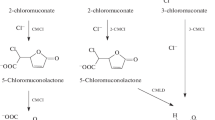Abstract
Two Rhodococcus strains, R. opacus strain AS2 and R. erythropolis strain AS3, that were able to use 4-nitroanisole as the sole source of carbon and energy, were isolated from environmental samples. The first step of the degradation involved the O-demethylation of 4-nitroanisole to 4-nitrophenol which accumulated transiently in the medium during growth. Oxygen uptake experiments indicated the transformation of 4-nitrophenol to 4-nitrocatechol and 1,2,4-trihydroxybenzene prior to ring cleavage and then subsequent mineralization. The nitro group was removed as nitrite, which accumulated in the medium in stoichiometric amounts. In R. opacus strain AS2 small amounts of hydroquinone were produced by a side reaction, but were not further degraded.
Similar content being viewed by others
References
Alexander M (1994) Effect of chemical structure on biodegradation. In: Biodegradation and Bioremediation (pp 159–176). Academic Press, San Diego
Bache R & Pfennig N (1981) Selective isolation of Acetobacterium woodii on methoxylated aromatic acids and determination of growth yields. Arch. Microbiol. 130: 255–261
Bernhardt FH, Nastainczyk W & Seydewitz V (1977) Kinetic studies on a 4-methoxybenzoate O-demethylase from Pseudomonas putida. Eur. J. Biochem. 72: 107–115
Bernhardt FH, Pachowsky H & Staudinger H (1975) A 4-methoxybenzoate O-demethylase from Pseudomonas putida: a new type of monooxygenase system. Eur. J. Biochem. 57: 241–256
Cartwright NJ & Smith ARW (1967) Bacterial attack on phenolic ethers: an enzyme system demethylating vanillic acid. Biochem. J. 102: 826–841
Duque E, Haidour A, Godoy F & Ramos JL (1993) Construction of a Pseudomonas hybrid strain that mineralizes 2,4,6-trinitrotoluene. J. Bacteriol. 175: 2278–2283
Edelson J & McMullen JP (1977) O-Demethylation of p-nitroanisole by Escherichia coli. Stimulation by phenobarbital. Drug Metab. Dispos. 5: 185–190
Frazer AC & Young LY (1986) Anaerobic C1 metabolism of the O-methyl-14C-labeled substituent of vanillate. Appl. Environ. Microbiol. 51: 84–87
Groenewegen PEJ, Breeuwer P, vanHelvoort JMLM, Langenhoff AAM, deVries FP & deBont JAM (1992) Novel degradative pathway of 4-nitrobenzoate in Comamonas acidovorans NBA-10. J. Gen. Microbiol. 138: 1599–1605
Haderlein SB & Schwarzenbach RP (1993) Adsorption of substituted nitrobenzenes and nitrophenols to mineral surfaces. Environ. Sci. Technol. 27: 316–326
Haigler BE & Spain JC (1993) Biodegradation of 4-nitrotoluene by Pseudomonas sp. strain 4NT. Appl. Environ. Microbiol. 57: 3156–3162
Haigler BE, Wallace WH & Spain JC (1994) Biodegradation of 2-nitrotoluene by Pseudomonas sp. strain JS42. Appl. Environ. Microbiol. 60: 3466–3469
Harms H & Zehnder AJB (1994) Influence of substrate diffusion on degradation of dibenzofuran and 3-chlorodibenzofuran by attached and suspended bacteria. Appl. Environ. Microbiol. 60: 2736–2745
Heudorf U & Peters M (1993) Umweltbelastung und Sanierungsverlauf nach dem Störfall in der Fa. Hoechst AG vom 22. 2. 1993. Forum Städte-Hygiene 44: 338–344
Higson FK (1992) Microbial degradation of nitroaromatic compounds. Adv. Appl. Microbiol. 37: 1–19
Jain RK, Dreisbach JH & Spain JC (1994) Biodegradation of p-nitrophenol via 1,2,4-benzenetriol by an Arthrobacter species. Appl. Environ. Microbiol. 60: 3030–3032
Karlson U, Dwyer DF, Hooper SW, Moore ERB, Timmis KN & Eltis LD (1993) Two independently regulated cytochromes P-450 in a Rhodococcus rhodochrous strain that degrades 2-ethoxyphenol and 4-methoxybenzoate. J. Bacteriol. 175: 1467–1474
Lenke H, Pieper DR, Bruhn C & Knackmuss H-J (1992) Degradation of 2,4-dinitrophenol by two Rhodococcus erythropolis strains, HL 24–1 and HL 24–2. Appl. Environ. Microbiol. 58: 2928–2932
Marvin-Sikkema FD & deBont JAM (1994) Degradation of nitroaromatic compounds by microorganisms. Appl. Microbiol. Biotechnol. 42: 499–507
Moir JWB, Baratta D, Richardson DJ & Ferguson SJ (1993) The purification of a cd 1-type nitrite reductase from, and the absence of a copper-type nitrite reductase from, the aerobic denitrifier thiosphaera pantotropha; the role of pseudoazurin as an electron donor. Eur. J. Biochem. 212: 377–385
Nishino SF & Spain JC (1993) Degradation of nitrobenzene by a Pseudomonas pseudoalcaligenes. Appl. Environ. Microbiol. 59: 2520–2525
Preuss A, Fimpel J & Diekert G (1993) Anaerobic transformation of 2,4,6-trinitrotoluene (TNT). Arch. Microbiol. 159: 345–353
Phys-Williams W, Taylor SC & Williams PA (1993) A novel pathway for the catabolism of 4-nitrotoluene by Pseudomonas. J. Gen. Microbiol. 139: 1967–1972
Schwarzenbach RP, Stierli R, Lanz K & Zeyer J (1988) Compound properties relevant for assessing the environmental partitioning of nitrophenols. Environ. Sci. Technol. 22: 83–92
Spain JC, Wyss O & Gibson DT (1979) Enzymatic oxidation of p-nitrophenol. Biochem. Biophys. Res. Commun. 88: 634–641
Spain JC & Gibson DT (1991) Pathway for biodegradation of p-nitrophenol in a Moraxella sp. Appl. Environ. Microbiol. 57: 812–819
Spain JC (1995) Biodegradation of nitroaromatic compounds. Annu. Rev. Microbiol. 49: 523–555
Spanggord RJ, Spain JC, Nishino SF & Mortelmans KE (1991) Biodegradation of 2,4-dinitrotoluene by a Pseudomonas sp. Appl. Environ. Microbiol. 57: 3200–3205
Sutherland JB (1986) Demethylation of veratrole by cytochrome P-450 in Streptomyces setonii. Appl. Environ. Microbiol. 52: 98–100
Wellens H (1990) Zur biologischen Abbaubarkeit mono-und disubstituierter Benzolderivate. Z. Wasser-Abwasser-Forsch. 23: 85–95
Zeyer J & Kearney PC (1984) Degradation of o-nitrophenol and m-nitrophenol by a Pseudomonas putida. J. Agric. Food. Chem. 32: 238–242
Zeyer J & Kocher HP (1988) Purification and characterization of a bacterial nitrophenol oxygenase which converts ortho-nitrophenol to catechol and nitrite. J. Bacteriol. 170: 1789–1794
Author information
Authors and Affiliations
Rights and permissions
About this article
Cite this article
Schäfer, A., Harms, H. & Zehnder, A.J.B. Biodegradation of 4-nitroanisole by two Rhodococcus spp.. Biodegradation 7, 249–255 (1996). https://doi.org/10.1007/BF00058184
Accepted:
Issue Date:
DOI: https://doi.org/10.1007/BF00058184




